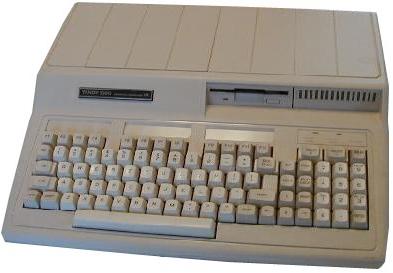CVGM.net - Chiptune, Demoscene and RetroGame Music

![[Computer » PC (PCjr / Tandy 1000 Series)]](/static/media/platform/symbol/platform_computer_pctandy1000.gif) Platform - Computer » PC (PCjr / Tandy 1000 Series)
Platform - Computer » PC (PCjr / Tandy 1000 Series)

Tandy:
"The Tandy 1000 was the first in a line of more-or-less IBM PC compatible home computer systems produced by the Tandy Corporation for sale in its Radio Shack chain of stores.
The machine was primarily aimed at the home and educational markets, and it copied the IBM PCjr's 16-color graphics (PCjr's graphics were an extension of CGA video) and 3-voice sound, but didn't use the PCjr cartridge ports. As the Tandy 1000 line outlasted the PCjr by many years (and in fact did not make it to market until shortly after IBM announced the discontinuation of the PCjr) these graphics and sound standards became known as "Tandy-compatible" or (for the graphics) "TGA" (standing for Tandy Graphics Adapter) and many software packages of the era listed their support for Tandy standard hardware on the package.
The SL series offered two innovations over the earlier SX series. One is high resolution (640x200) 16 color graphics; the other is an improved sound circuit, using an 8-bit mono DAC alongside the PSSJ 3-voice sound source. The DAC gave the SL series digital sound output capabilities not much unlike those of the early 8-bit SoundBlaster line of audio cards: 3 PCM voices, 8-bit DMA up to 22050 KHz, audio mono output, audio mono inputs (mic + line), sampling at 5512 KHz, 11025 KHz and 22050 KHz. "
PCjr:
"Announced November 1, 1983, and first shipped in March 1984, the PCjr (referred to internally by IBM as "Green Dragon", and later called "Peanut" by several trade publications[citation needed] until a short while after its debut) came in two models: the 4860-004, with 64 KB of memory, priced at US$669; and the 4860-067, with 128 KB of memory and a 360 KB 5.25-inch floppy disk drive, priced at US$1269. It was manufactured for IBM in Lewisburg, Tennessee by Teledyne. Roughly 500,000 units were shipped. The PCjr promised a high degree of compatibility with the IBM PC, already a popular business computer, and offered built-in color graphics (via a graphics chip known as the "VGA", which stood for "Video Gate Array," which was an extension of CGA - not to be confused with the later VGA (Video Graphics Array) chip and standard that IBM released with its PS/2 line in 1987) and 3-voice sound (provided by a Texas Instruments SN76489 which could produce three square waves of varying amplitude and frequency along with a noise channel powered by a shift register) that was better than the standard PC speaker sound and color graphics of the standard IBM PC and compatible machines of the day. The PCjr was also the first PC compatible machine that supported page flipping for graphics operation. Since the PCjr used system RAM to store video content and the location of this storage area could be changed, the PCjr could perform flicker-free animation and other effects that were either difficult or impossible to produce on contemporary PC clones."


















 Songs
Songs

![Deceased [On 2005-01-26] Deceased](/static/deceased.png)

